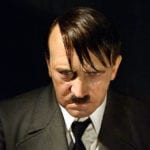 Weird Stuff
Weird Stuff  Weird Stuff
Weird Stuff  Mysteries
Mysteries 10 Tragic Disappearances and Deaths in Joshua Tree National Park
 History
History 10 Ways Childhood Really Sucked in the Old West
 Music
Music 10 Name Origins of Famous Bands from the 1990s
 Religion
Religion 10 Biggest Turnarounds by the Catholic Church
 Weird Stuff
Weird Stuff 10 Unbelievable Times Laws Had Unintended Consequences
 Humans
Humans Ten Historic Women Who Deserve Way More Credit Than They Got
 Movies and TV
Movies and TV 10 Films That Spawned Major Lawsuits
 History
History Ten Times Towns Were Wiped Off the Face of the Earth
 Creepy
Creepy 10 of the Most Disturbingly Haunted Public Houses in the UK
 Weird Stuff
Weird Stuff 10 Niche Subcultures That Are More Popular Than You Might Think
 Mysteries
Mysteries 10 Tragic Disappearances and Deaths in Joshua Tree National Park
 History
History 10 Ways Childhood Really Sucked in the Old West
Who's Behind Listverse?

Jamie Frater
Head Editor
Jamie founded Listverse due to an insatiable desire to share fascinating, obscure, and bizarre facts. He has been a guest speaker on numerous national radio and television stations and is a five time published author.
More About Us Music
Music 10 Name Origins of Famous Bands from the 1990s
 Religion
Religion 10 Biggest Turnarounds by the Catholic Church
 Weird Stuff
Weird Stuff 10 Unbelievable Times Laws Had Unintended Consequences
 Humans
Humans Ten Historic Women Who Deserve Way More Credit Than They Got
 Movies and TV
Movies and TV 10 Films That Spawned Major Lawsuits
 History
History Ten Times Towns Were Wiped Off the Face of the Earth
 Creepy
Creepy 10 of the Most Disturbingly Haunted Public Houses in the UK
10 Unexpected Silver Linings Of The First World War
World War I was one of the biggest disasters of the 20th century. Exactly a century ago this year, the European superpowers’ combined forces launched a pointless and futile war that sucked in the entire world and killed well over 15 million people. It was an unimaginable tragedy, one made even worse when you realize it led directly to the atrocities of World War II.
But, amid all the death and the mud, there were a handful of silver linings. Advancements in medicine, science, and engineering may not exactly make the war a necessary evil, but they sure give some meaning to all those lost lives.
10 Plastic Surgery

Although we like to hide it behind cold statistics and euphemisms like “walking wounded,” war is messy, painful, and disgusting. Instead of dying, people cling to life with half their face missing or a gaping hole where their nose used to be. A record number of young men poured into hospitals during the war with disfigurements almost incomprehensible to people at the time. Yet it was from these horrors that modern reconstructive surgery was born.
Earlier, plastic surgery was almost unbelievably crude. Although you could wind up with something that functioned as, say, a repaired mouth, it almost certainly wouldn’t look like one. But that all changed thanks to Harold Gillies, a British surgeon tasked with rebuilding disfigured soldiers after a little something known as the Battle of the Somme.
Overwhelmed with casualties and suddenly being asked to reconstruct entire faces from scratch, Gillies and his team were left with no choice but to dream up and pioneer radical new techniques. Incredibly, most of them were completely successful. So successful, in fact, that plenty of them are still in use today. It’s thanks to these advances that someone in the 21st century can lose literally their entire face and eventually be returned to looking more-or-less normal.
9 Psychiatry

The physical wounds caused by shells, gunfire, and gas in the war may have been shocking, but just as damaging were those wounds that only existed in the head. For the first time in history, World War I saw psychiatry become mainstream, as governments and armies strained to understand the phenomenon of shellshock.
Originally thought to be caused by physical damage to the brain, shellshock soon became known as a mental reaction to the horrors of trench warfare. Worryingly, it was also one that cut across class divides: In Britain, officials uncomfortably noticed that the ratio of officers to enlisted men incapacitated by shellshock was 1:6. The ratio of healthy officers to healthy enlisted was 1:30. It was painfully obvious something needed to be done about this new disorder.
That “something” was the development of psychiatric methods. While some were grim, such as electric shock treatment. others showed a new level of understanding for mental disorders. At Lennel in England, Winston Churchill’s wife Lady Clementine became an early adopter of occupational therapy, a treatment still used today. Other treatments—like rest, rehabilitative activities, and the “talking cure”—became standards. These suffering soldiers may have been regarded as a source of shame by their superiors, but their treatment opened the doors to psychotherapy in the military, the positive effects of which can still be seen even now.
8 The UN

Although the UN was born from the ashes of Auschwitz, Stalingrad, and Hiroshima, it was the trenches of the First World War that made its current format possible. In the immediate aftermath of Allied victory, it was decided that an organization should be set up to prevent such a large-scale war from ever happening again. The resulting of 42-country union was known as the League of Nations.
Nowadays, the League is rightfully seen as a bit of a joke. It was weak, prone to infighting, and ultimately failed in its one goal of stopping another global war. But it laid the foundations for everything we recognize in the modern UN. The idea of an international court grew from a League of Nations’ attempt to set up its own. The UN mandate of “peacekeeping” is also derived from the League, as is its International Labor Organization.
And you’d better believe the UN has done some great things in the world. For every failure (such as Rwanda or Bosnia), they have a whole list of incidents they stopped from spiraling into outright war—and wars they stopped from becoming genocides.
7 A Strong North America

As hard as it seems to believe now, prior to 1914 North America was basically a backwater. The big players on the world stage were all European. Britain was the most powerful country on Earth, and France, Germany, and Russia dominated entire continents. The Germans characterized America’s military strength (not inaccurately) as somewhere “between Belgium and Portugal.”
That all changed with World War I. The mainland European powers were physically devastated and Britain was gripped by the worst recession in 100 years. The result? America, newly emboldened by its decisive role in the war, could emerge as a fully-formed superpower.
But the US wasn’t the only nation on the continent to benefit. Thanks to Prime Minister Borden and the country’s key role supporting the Allies, Canada became bold enough to step out from Britain’s shadow, demanding its own place at the League of Nations and making the public transition from “former colony” to respected nation. Even Mexico, which had declined to enter the conflict, received a mild economic boost at the height of its revolution.
6 Aviation

All wars bring their own technological advancements, but nowhere has this been plainer than in the speedy development of aviation during World War I. Before the conflict, air travel was a dangerous sport rich guys conducted in rickety biplanes. By the end it was ready to become an industry.
Thanks to war-minded governments pouring absurd sums of money into the technology, aircraft became safe and capable of flying long distances. In 1919, John Alcock and Arthur Brown made the first non-stop transatlantic flight using a modified World War I fighter plane. It took them less than 17 hours, a seemingly impossibly short time in the days of week-long crossings on ships. Thanks to zeppelin technology pioneered during the German war effort, the first regular commercial flights between Europe and North or South America also became available, paving the way for the regular routes of today. That’s before we even get onto other advances like the birth of aircraft carriers.
5 Banning Chemical Weapons

In a war of such unimaginable suffering and brutality, it’s difficult to pinpoint one single “worst” moment. But the use of chemical weapons on the battlefields of France may well be it. Between 1915 and 1918, hundreds of tons of chlorine, phosgene, and mustard gas were dropped by both sides. The result was severe lung damage, burnt and blistered skin, blindness, and even death for hundreds of thousands of men. The damage inflicted by these weapons created so much widespread public disgust that it directly led to the creation of the Geneva Protocol.
Spearheaded by the US, the protocol sought to stop chemical weapons from ever being used again, and it was remarkably successful at this goal. According to the International Red Cross, the Protocol has been respected in nearly every single conflict from 1925 onwards, a remarkable feat only matched by the global rejection of nuclear weapons after World War II.
Although the protocol itself has long-since been superseded by newer treaties, its effects are still felt today. The lingering memory of the mustard gas attacks at Ypres is the reason our troops don’t come home from Afghanistan disfigured by chemical agents. It’s also the reason the Sarin attack in Syria was so shocking. It may be small comfort to those who suffered in France, but their awful experiences meant few ever had to experience such horror again.
4 Blood Transfusions

Blood transfusions are one of those things that we now almost take for granted. But as late as 1912, they were known as a super-risky procedure with a stratospherically high mortality rate. That all changed with the coming of war.
As with plastic surgery, doctors in the Great War were forced to take risks and try out new transfusion techniques on the fly or watch their patients die agonizing deaths. Almost everything we associate with successful transfusions came from this desperation. In 1916, Bruce Robertson of the Canadian Army introduced the technique of using a syringe and cannula to get blood into a dying patient. Up until that point, doctors had literally had to open up a healthy person’s veins and pump their blood directly into the wounded.
Fast forward a year and Oswald Robertson of the US army became the first person on Earth to realize you could collect and store blood for future transfusions. That’s right: You can directly thank Major Oswald and World War I for the existence of blood banks, something that has saved untold millions of lives.
3 Poetry And Art

World War I didn’t just inspire the odd ditty—it’s directly responsible for some of the greatest works in literature.
Take the work of Isaac Rosenberg. A poor East End Jew from London, Rosenberg documented the horrors of trench warfare in verses that remain incredibly powerful today. Nor was he the only one. A whole cohort of English conscripts led by Siegfried Sassoon and Wilfred Owen conspired to create works that are now considered some of the finest the English language ever produced. Other countries saw similar surges in literature. Canadian John McCrae’s Flanders Field is still studied around the world, while in France, Guillaume Apollinaire basically invented surrealism.
But it wasn’t just poetry the Great War inspired. Painting, plays, novels, and music all transformed in the face of this gigantic catastrophe. Without the war, we probably wouldn’t have the best work of artists as diverse as Ernest Hemmingway, Otto Dix, Virginia Woolf, Arnold Schoenberg, or John Dos Passos.
2 Women’s Rights

If you were born female prior to Word War I, life usually meant a hasty marriage, years of domestic drudgery, and no say whatsoever in how your country was being run. That all changed with the Great War.
Suddenly, politicians needed women out the house and into work. In the US, 30,000 women became actively involved in the services, with many thousands more employed on the fringes. In Britain, at least two million women entered the workforce, many learning skills that had previously been off-limits to anyone without a penis. The result of this sudden social transformation was profound. In Britain, the era of working class women making a living as servants came to an end. In the US, African-American women were even brought into the military.
But nothing comes close to getting the vote. Following the war, President Woodrow Wilson himself became an ardent champion of female suffrage. Thanks to the sacrifices of women in the war, in 1920 the 19th amendment made women equal citizens. In Britain things were slower but no less epoch shaking. In 1918, 40 percent of all women (those over 30 who owned property) were enfranchised, starting the steady march towards equality.
1 Spreading Democracy

When Britain entered the war in 1914, it couldn’t be called a democracy by any stretch of the imagination. The country was run by extras from Downton Abbey, and being working class usually meant not having a vote. The rest of Europe was generally not much better. It was a world for aristocrats and bishops, not ordinary people. When war broke out, many of those fighting had no say in how the country they were dying for was run.
The war changed all that. In Britain, the old class system was delivered a blow from which it never fully recovered. As a direct result of all the sacrifices made, the government passed an act giving the vote to all male citizens over the age of 21, regardless of location or income. A decade later, an amendment to the act would extend equal voting rights to women. Across the continent, social movements began to flourish with ordinary people’s rights at their heart. For the first time in European history, ideas of equality were beginning to take root in nearly every country.
There’s no doubt that the First World War was a disaster. But it’s comforting to know that even out of the worst conflict in European history, some good (however small) could still arise.








